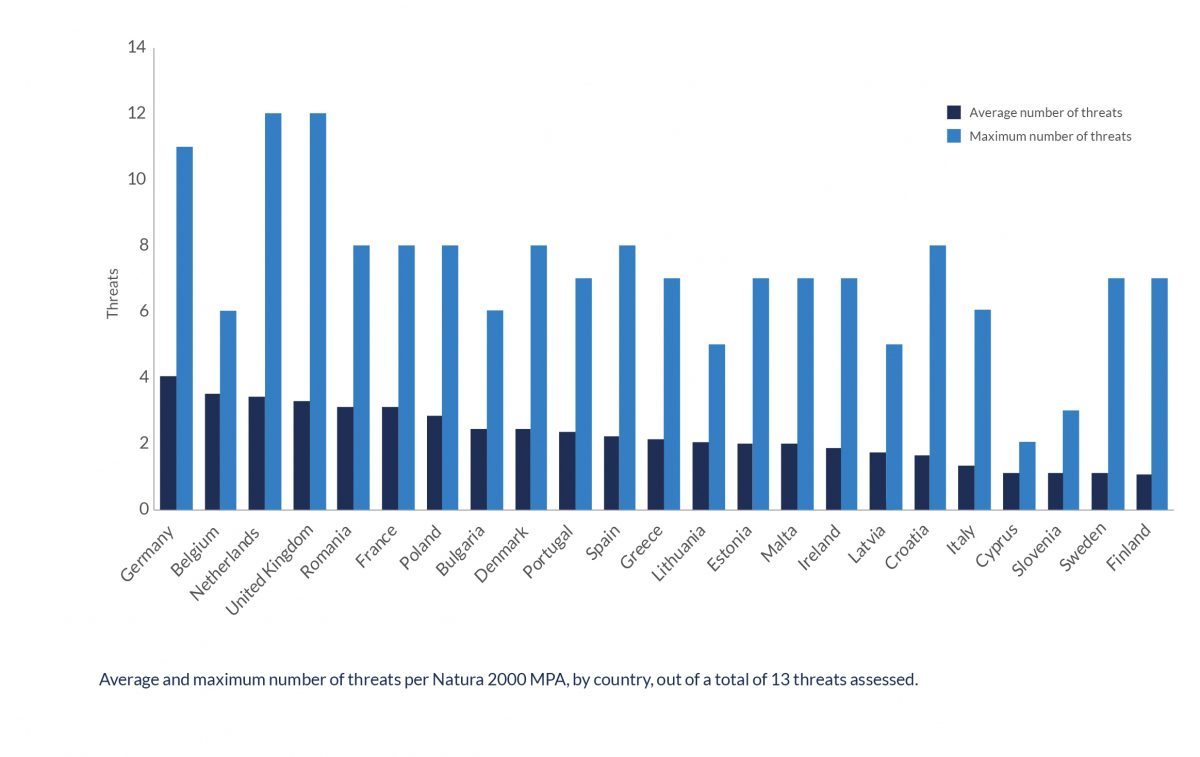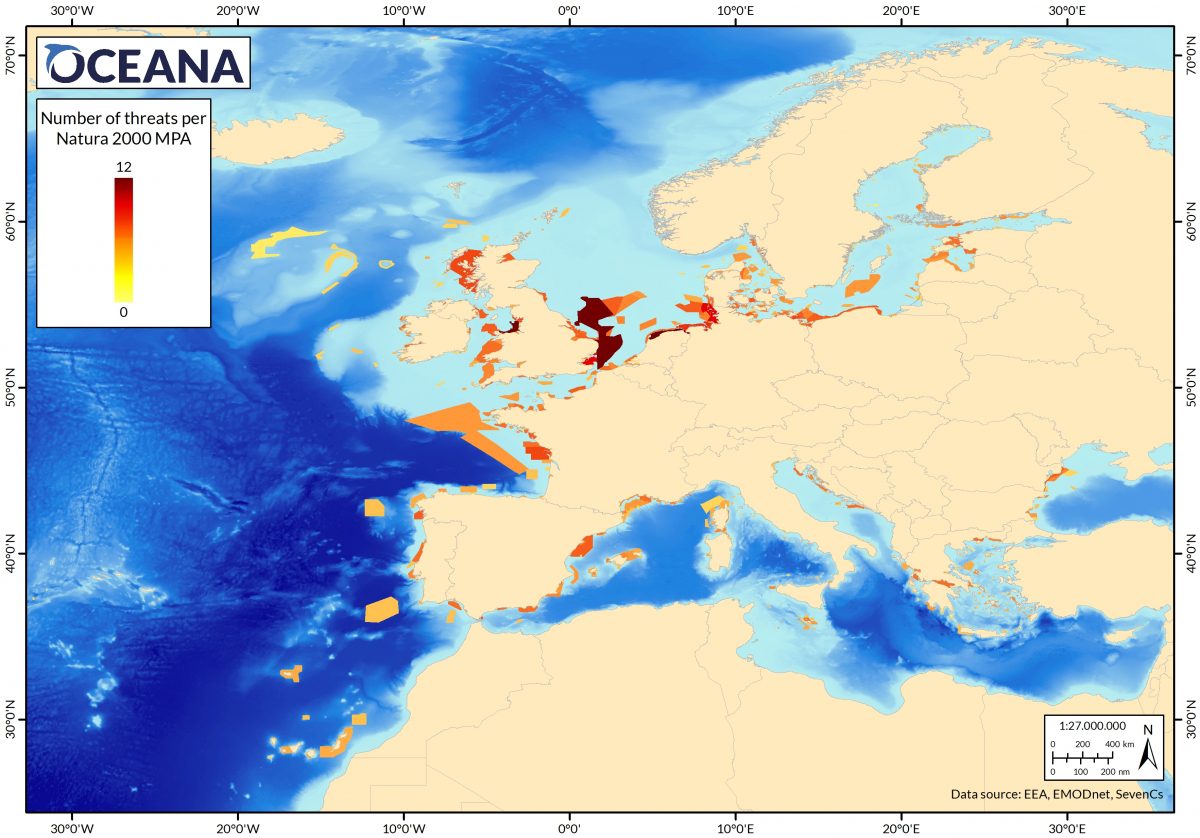New study reveals extent of European marine paper parks: 96% allow destructive activities inside their boundaries
Oceana calls on European Commission to prohibit bottom-trawling in all EU MPAs to fix current failed management approach
Press Release Date: December 14, 2020
Location:
Contact:
Emily Fairless, Communications Officer | email: efairless@oceana.org | tel.: +32 478 038 490
European Marine Protected Areas (MPAs) are mere ‘paper parks’ that provide little actual protection, a report released by NGO Oceana reveals. Seventy percent of 3449 Natura 2000 MPAs assessed were affected by at least one major threat1, with up to 12 threats found inside some sites in the Netherlands and in the UK. Only 0.07% of the total MPA network area was unaffected by any of the threats assessed, while damaging fishing gear affected 86% of the network intended to protect habitats.
Vera Coelho, Senior Director, Advocacy at Oceana in Europe, said: “Our study quantifies, for the first time, the appalling extent to which Europe’s largest MPA network is essentially made up of ‘paper parks’. To match their ambitious rhetoric on targets for marine protection, it is essential that European governments and the European Commission prohibit extractive and industrial activities that take place inside MPAs as they are fundamentally incompatible with the concept of protected areas.”
Data from Oceana’s research reveal that 96% of the Natura 2000 MPA network is not protective enough, as sites allow at least one extractive or industrial activity, or infrastructural development within their boundaries. According to international standards from the IUCN adopted in 20162, such areas should not meet the definition of an MPA. This suggests that less than 0.5% of European seas, corresponding to an area the size of Belgium, is protected within real MPAs that restrict environmentally damaging industrial activities.
Oceana’s analysis also found that over 53% of a selection of MPAs assessed had not reported any management. Where such plans did exist, 80% of them proved to be generally incomplete and characterised by weaknesses such as a failure to address major threats impacting sites. The adoption of management had often been seriously delayed – leaving sites unmanaged for up to 11 years.
Nicolas Fournier, Campaign Director, Marine Protection at Oceana in Europe, added: “While the EU and the UK now aim for 30% of MPAs by 2030, a radical change is needed to give MPAs actual teeth to restrict economic activities and effectively protect nature, especially in a degraded marine environment facing significant and increasing pressures, including from climate change.”
During the last decade, the race to designate MPAs has meant that quantity has come at the cost of quality, with many MPAs designated on paper but with no management. Oceana’s analysis shows many MPAs aim to deliver just a ‘legal minimum’ to protect a limited number of features in each site rather than the wider ecosystem, and largely fail to address widespread threats like maritime traffic, fishing and dredging. This failure is further evidenced by the ongoing decline of marine species and habitats inside European MPAs, as confirmed by the European Environment Agency’s latest State of Nature report3.
Oceana calls on national governments to radically change their management and adopt broad-scale prohibitions of activities incompatible with MPA objectives. In addition, the upcoming 2021 EU Action Plan to conserve fisheries resources and protect marine ecosystems will be a make-or-break moment for the European Commission to show its ambition to tackle destructive fishing in European MPAs and deliver on its ocean biodiversity targets.
 |
 |
|
Average and maximum number of threats per MPA, by country, out of a total of 13 threats assessed. |
Total number of recorded threats per MPA (out of a maximum of 13 threats assessed) in 2018. |
At a glance:
- 551 296 km2 of marine area covered by Natura 2000 MPAs in 2018
- 380 km2 of total area not affected by any of 13 threats assessed
- 0 countries with fewer than 50% of their MPAs facing threats
- 510 of habitat-‘protecting’ MPAs allow habitat-damaging fishing gear
- 86% of ‘protected’ seabed in MPAs exposed to high-risk fishing gear
- 47% of MPAs assessed reported having a management plan
- 80% of management plans assessed failed to lay a solid basis for management
- 12 threats (out of 13) identified in some ‘protected’ areas
- 0.4%: Percentage of European marine area protected by real MPAs in 2018
- 30% of marine area effectively protected by 2030, is the new commitment made by the EU and the UK
Visit our online viewer to explore threats in European MPAs in more detail
# # #
This Press Release is also availiable in:
Notes to editors


